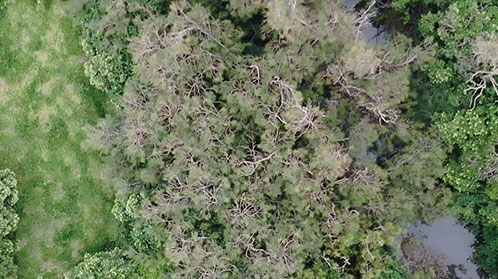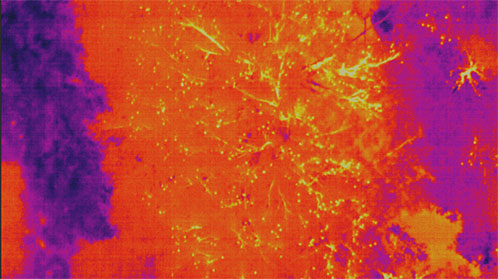Counting flying-foxes by using drones equipped with thermal cameras


Scientists from Western Sydney University and the Taronga Conservation Society have published a new method in the journal Remote Sensing In Ecology and Conservation for detecting and counting flying-foxes in tree canopies by using thermal camera-equipped drones.
This innovative new method, published in the journal Remote Sensing in Ecology and Conservation (opens in a new window), contributes to efforts to count grey-headed flying-foxes (Pteropus poliocephalus), a species listed as vulnerable to extinction due to population decline.
The new method is shown to be accurate and precise, by comparing ground counts of flying-foxes in single trees to counts obtained from the drone, from repeated drone surveys, and from multiple human counters.
The work also uses advanced image detection techniques including machine-learning and computer vision methods to semi-automate flying-fox counts from the drone-acquired imagery.
“We can now use drones to obtain accurate and precise measures of colony abundance semi-automatically, thus greatly reducing the amount of human effort involved for obtaining abundance estimates”, said lead author and Master of Research graduate Eliane McCarthy at the Hawkesbury Institute for the Environment.
“At present there are two main methods for getting accurate counts of a flying-fox colony: during the day, when the flying-foxes are roosting and therefore quite static, or during the evening when they leave the roost to forage on nectar and fruit and can be counted as they depart the roost”, said Ms McCarthy.
“However, there are several issues in conducting ground surveys: the terrain can be difficult and physically-challenging for counting personnel and their presence can disturb rooting flying-foxes, reducing the accuracy of the estimate. Fly-out counts rely on rapidly counting fast-moving animals at dusk, when the light is fading, complicating these assessments”, said co-author Dr John Martin, a research scientist at Taronga.
“We demonstrated that drone-acquired thermal imagery can be used to accurately and precisely quantify the abundance of flying-foxes in a roost, and that semi-automated methods for counting flying-foxes in thermal imagery are comparable to human assessments in their accuracy”, said co-author Associate Professor Boer.
“This method is very valuable for reliably monitoring the abundance of individuals in flying-fox roosts and will aid in the conservation and management of this globally threatened group of flying-mammals, as well as other warm-blooded tree-roosting species”, said senior author Associate Professor Justin Welbergen.
ENDS
23 April 2021
David Thompson - Media Officer (0429 951 552)
Latest News

ABC RN transcript: Vice-Chancellor Professor George Williams discusses higher education sector, student support, and the impact of AI
The following is a transcript of an interview that aired on ABC Radio National Saturday Extra between presenter, Nick Bryant and Vice-Chancellor, Distinguished Professor George Williams AO.

Western Sydney University are the number one Australian solar car team at the 2025 Bridgestone World Solar Challenge
Western Sydney Solar Car team has crossed the finish line placing preliminarily sixth in the world overall, and the number one Australian team in the world’s most prestigious solar car challenge.

Western Sydney University Statement on Cyber Incidents
Western Sydney University has issued an update to its community following confirmation that previously stolen personal information was published online, including on the dark web.
Mobile options:

